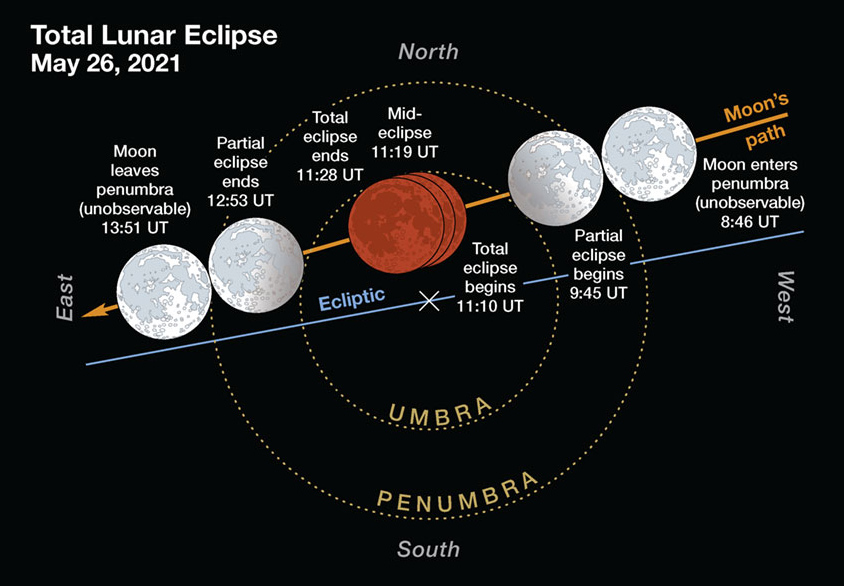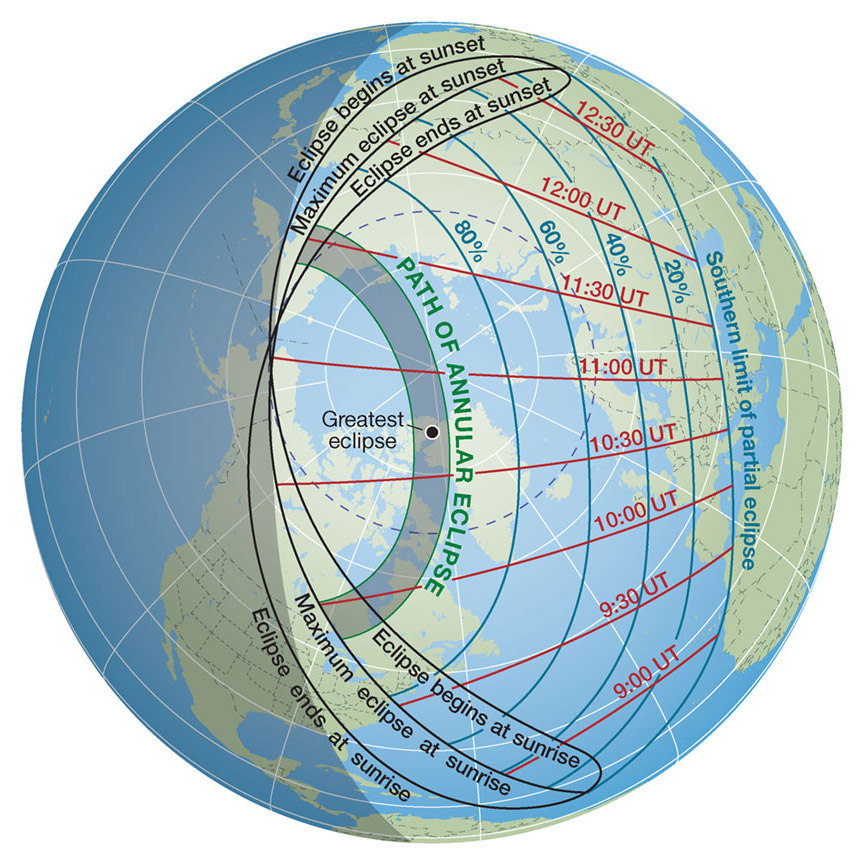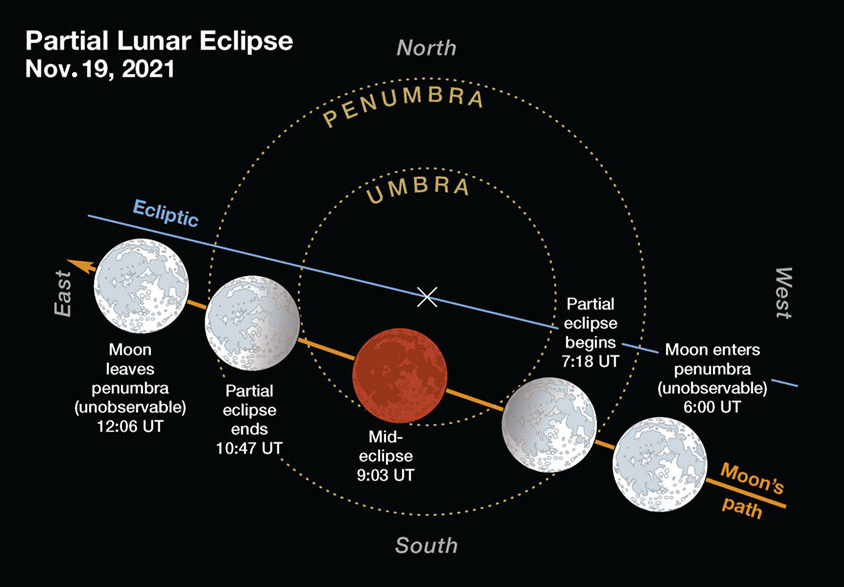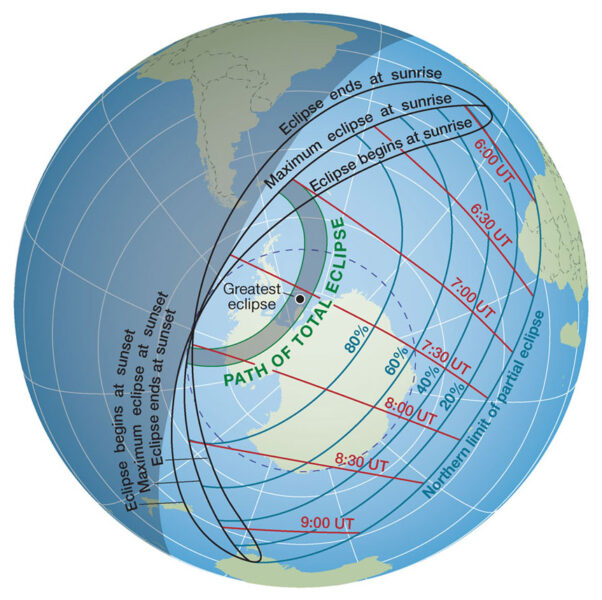28.01.2021
THE FOUR ECLIPSES OF 2021
Below are brief descriptions of the four eclipses that take place in 2021. You’ll find more details in Sky & Telescope magazine or on this website as the date of each draws near. Times are given in Universal Time (UT) except as noted. Adjust these to get those for your time zone: for example, PST = UT – 8, and EST = UT – 5. (But be sure to allow for daylight or “summer" time: PDT = UT – 7, and EDT = UT – 4.)

Jay Anderson
| Date | Type | Maximum | Visibility |
| May 26 | Total lunar eclipse | 11:19 UT | E. Asia, Australia, W. North America |
| June 10 | Annular eclipse | 11:01 UT | Canada, Greenland, Siberia |
| November 19 | Partial lunar eclipse | 9:03 UT | E. Asia, Australia, N. and S. America |
| December 4 | Total solar eclipse | 4:08 UT | Southern Ocean, Antarctica |
May 26: Total Lunar Eclipse

Sky & Telescope; source: USNO
The year’s first eclipse doesn’t occur until the 146th day of 2021, but it’ll be a good one: It’s the first total lunar eclipse in nearly 2½ years. The timing benefits anyone living around the Pacific Ocean. Mid-eclipse takes place after sunset for easternmost Asia, Australia, and New Zealand; around 1 a.m. in Hawaii; and before dawn in western North America and from the tip of South America. Those in eastern North America have to settle for glimpsing the last partial phases before dawn — or maybe nothing at all.
This is not be a particularly “deep” eclipse, as the entire Moon just barely becomes fully engulfed by Earth’s umbra. Those able to witness totality should look for a distinct brightening on the northern half of the lunar disk. Also, the eclipse occurs with the Moon positioned in the head of Scorpius, so watch for the summer Milky Way to eerily emerge into view at mid-eclipse even though the full Moon completely overwhelms it just an hour before or after the eclipse takes place.
June 10: Annular Solar Eclipse

Sky & Telescope; source: Fred Espenak
Two weeks after May 26th’s total lunar eclipse — after the Moon’s phase evolves from full to new — the Sun, Moon and Earth again line up to create an annular solar eclipse on June 10th. (Notably, last year an annular eclipse occurred on June 21st.) As the global map above shows, viewing this event at its best will be challenging. The lunar shadow touches down in southern Canada at dawn before racing northeastward across Hudson Bay, northwestern Greenland (where annularity is longest, 3m 51s), the North Pole, and eastern Siberia.
Those in the U.S. Northeast and eastern Canada have a chance to see the Sun rise as a partly eclipsed disk — 73% covered from Boston, for example. Here’s a timetable for selected cities in North America (click on “North America” in Section 2). Virtually all of Europe and Asia are also positioned to experience a partial eclipse.
| Sky & Telescope is sponsoring an exclusive chartered flight to view June 10th’s annular eclipse from southern Canada. Please check here again for a link that will provide more details and pricing. |
November 19: Partial Lunar Eclipse

Sky & Telescope; source: USNO
The geometric circumstances for the year’s second lunar eclipse are interesting. Rarely does the Moon plunge so deeply into Earth’s umbra without being completely engulfed. In this case, at mid-eclipse 97.4% of the lunar disk lies inside the umbra and the remaining 2.6% just outside in the deepest part of the penumbra. Consequently, the interplay of shading and color across the Moon’s eclipsed face promises to be especially entertaining.
Weather permitting, everyone in North America gets to view November 19th’s lunar eclipse — though not at particularly convenient times. As the diagram above shows, mid-eclipse occurs at 9:03 Universal Time, which corresponds to 4:03 a.m. Eastern Standard Time and 1:03 a.m. Pacific Standard Time. (Maybe we should all plan a trip to Hawaii, where the eclipse peaks at a more reasonable 11:03 p.m. on the evening of November 18th.)
Throughout this not-quite-total eclipse, you might consider performing a bit of “citizen science” by using a telescope to study the progression of the umbra’s abrupt edge across the lunar disk and to record the times when it covers or uncovers particular craters. Here’s an introduction to making these crater timings and other worthwhile observations during a lunar eclipse.
December 4: Total Solar Eclipse

Sky & Telescope; source: Fred Espenak
The final eclipse of the year is the one that “umbraphiles” the world over are waiting for. You’ll perhaps recall that the Moon’s umbral shadow swept across central Chile and Argentina last December — but the global pandemic prevented virtually everyone from traveling to see it. Even for those already there, a nasty rainstorm blocked the view of totality from within the path in Chile.
So eclipse-chasers are planning to head once more to the Southern Hemisphere for the total solar eclipse on December 4th. Unfortunately, Mother Nature has again dealt them challenging circumstances. As the map above shows, the path of totality is restricted to vast tracts of the Southern Ocean and Antarctica. The greatest duration of totality, a modest 1m 54s, occurs off the Antarctic coast in the Weddell Sea.
Partial phases will just barely be visible from southernmost Africa, southeastern Australia (a scant 2% in Melbourne), and Tasmania.
This eclipse occurs just 17 days before December’s solstice, so virtually everything poleward of the Antarctic Circle is bathed in constant sunlight. Look closely at the global map, and you’ll notice that the path of totality falls on the “nighttime” hemisphere of Earth. Consequently, the lunar shadow will move over Earth’s surface from east to west, rather than the expected west to east. This quirky geometry last occurred during the total solar eclipse on November 23, 2003.
Since December 4th’s eclipse happens near the peak of austral summer, many cruise ships are planning to position themselves in the path of totality. But according to Jay Anderson, a veteran meteorologist and diehard eclipse-chaser, the weather prospects where the path crosses the open ocean are not encouraging. One spot offering a better-than-average chance of clear skies is the group of tiny South Orkney Islands, which barely lie withing the umbral path.
Quelle: Sky&Telescope
